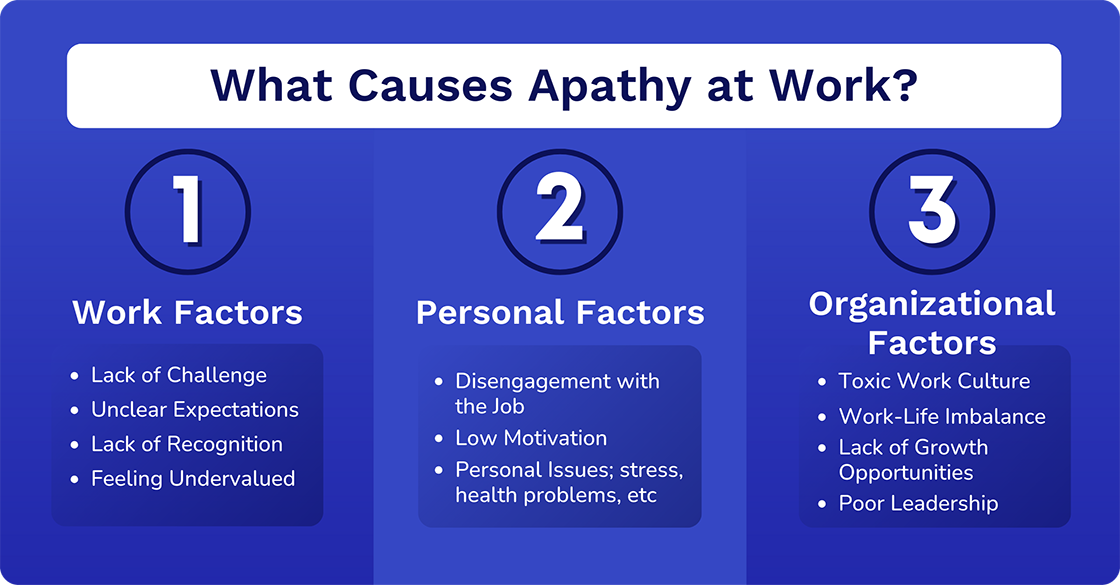Employee disengagement and apathy at work are huge problems. Learn more about them and discover how you can counter their negative effects

.png)
It can be difficult to know what to include in an employee survey. That’s why we have created a template that you can use for FREE to ensure your employee surveys are engaging. Get the responses that will help you understand your audience.
Access NowApathy at work has been called a silent epidemic. Unlike the outbursts of frustration that are often associated with burnout, workplace apathy manifests as quiet disengagement that typically results in a slow decline in enthusiasm and motivation. It can be difficult for employees to fight the feelings of indifference, detachment, listlessness, and lethargy that go with apathy. However, there are positive steps that organizations can take to counteract apathy and the negative effects of a disengaged workforce.
The first step is to identify workplace apathy and disengagement. This disengagement can often stem from apathy, which is a feeling of indifference or lack of motivation that can significantly impact productivity and morale.
Since 2009, the global analytics and advisory firm, Gallup has been measuring global engagement. After declining in 2020, they stated that it reached a record high in 2022. But in January 2024, Chief Scientist of Workplace Management and Wellbeing at Gallup, Jim Harter, reported that engagement in the U.S. workplace was stagnating. The percentage of actively disengaged employees had declined to 16% in 2023, and only 33% were engaged. Those employees who weren’t engaged or who were actively disengaged had cost the U.S. economy an estimated $1.9 trillion in lost productivity.
Of course, everyone was hoping things would improve in 2024. But in April 2024, Jim Harter wrote U.S. Engagement Hits 11-Year Low. Alarmingly, 4.8 million fewer U.S. employees were engaged in the first three months of 2024.
While apathy and disengagement are not the same thing, there is no doubt that workplace apathy can be a major driver of employee disengagement. With that in mind, we have developed a guide to help you spot apathy, understand its causes, and most importantly, reignite passion in your employees.
Employee disengagement is part of a spectrum. At one end you have highly engaged employees who are enthusiastic and motivated. In the middle, you have neutral employees who might not be actively disengaged but aren't particularly invested either. At the other end, you have employees experiencing apathy and high levels of disengagement.
As mentioned above, apathy can be a cause of employee disengagement. This is, quite simply, because when employees feel apathetic, they lack the motivation, interest, or emotional connection to their work. This can lead to:
In a February 2024 Gallup article, The New Challenges of Engaging Younger Workers, Jim Harter pointed out that engagement trends vary widely across age generations. While younger employees feel the most detached from their work and employers, baby boomers tend to remain engaged.
Advice from Gallup is to:
Craft effective surveys to measure employee sentiment and boost engagement
.png)
Apathy is characterized by a general lack of interest, enthusiasm, or motivation. In the office, it shows up as employees:
Some people identify workplace apathy with boredom. But they are not the same.

While boredom can lead to apathy, it often stems from repetitive tasks. Bored employees might seek stimulation but still have a desire to contribute. Burnout, on the other hand, is caused by chronic stress and overwork. Burned-out employees might be exhausted and cynical, but they likely had an initial passion for their work.
The Singapore-based Aventis Centre for Wellness & Organizational Psychology identifies apathy as a more prolonged and “stable” state than boredom. “Unlike boredom, where emotions change, nothing excites, pleases, or interests an apathetic person.”
Furthermore, short-term boredom has its advantages.
“Studies have shown that a temporary lack of stimulation increases creativity and motivation. Being apathetic and passive, on the other hand, works against your self-interest.”
Aventis
Apathy can be a symptom of various issues, both personal or caused by work factors and/or issues that stem from within the organization.

The consequences of a workplace filled with apathetic employees can be far-reaching:
Aventis Centre warns that chronic apathy at work isn't just a drag on your mood. It's a virus that spreads to every aspect of your well-being. It fuels stress, anxiety, and depression, crushes productivity, and turns your workplace toxic. And here's the kicker — apathy clings to you, following you even if you switch careers. It doesn’t matter whether you’re in a leadership role or in a baseline position in a company.

So, let’s talk about apathetic leadership and the devastating effect apathetic leaders can have. We’ve identified two authorities on the topic.
Jason Compton, Environmental Health and Safety expert with Cardinal Health, pinpoints how a rise in apathetic leaders is killing employee morale and engagement. In an article posted on LinkedIn, he draws attention to the crucial role leaders play in driving the engagement of employees and boosting their morale.
He identifies how great leaders cultivate a positive work environment, ignite team motivation, and steer everyone toward shared goals. Unfortunately, a worrying trend has emerged in the form of apathetic leadership. These leaders display indifference towards their own roles and, worse yet, the roles of their team members. This apathy has a ripple effect, eroding employee engagement, morale, safety, and ultimately, organizational productivity. The result? Increased internal and external risks to the company's success.
“An apathetic leader is someone who lacks passion, empathy, and motivation in their leadership role. They show little interest or concern about things that used to matter to their organization or the goals that matter to those they work with daily. Although they may possess the necessary skills and knowledge to read a profit and loss statement, they lack the drive to inspire and engage their team.”
Jason Compton
His primary concern is that organizations must identify apathy in leaders to avoid the negative impact of apathetic leadership on employees. He recognizes that this is essential to create motivation and engagement.
Craft effective surveys to measure employee sentiment and boost engagement
.png)
Jessica Kriegel, Chief Scientist of Workplace Culture at Culture Partners, is also acutely aware of the apathy crisis and the role leadership has to play. In an article, The Apathy Crisis And The Role Of Leadership published on LinkedIn, she identifies the roles of leadership in different levels of organizations showing that a big problem is that many aren’t clear on their priorities.
Examples she cites include tasks that people spend days doing that nobody will ever notice or read. She also highlights the fact that many stress, burnout, and mental health challenges are because of bad management.
“If we clear up some of the priority hurdles inside organizations, we can get more clarity on who should be doing what, which makes the culture piece more logical and reduces some of the languishing and malaise.”
Jessica Kriegel
It’s not difficult, but it does take thought and effort to counter apathy and re-engage employees. Here are four broad strategies to help you combat apathy and reignite passion in your team.
Apathy can be a real buzzkill in the workplace, leading to disengaged employees and a stagnant work environment. But don’t worry, it’s not a big problem! By focusing on job enrichment and growth opportunities, you can reignite employee passion and create a more fulfilling work experience.
By implementing these initiatives and opportunities, you can transform mundane jobs into enriching experiences with clear growth paths. This not only combats apathy but also fosters a more engaged and productive workforce, ultimately benefiting both employees and the company.
You can boost communication for engaged employees and transform feedback into a growth tool. Both of these approaches will help you to improve communication and feedback.
First, realize that apathy thrives in the dark. By fostering open and transparent communication, you can empower employees, address concerns, and reignite their interest.
Then make sure that feedback doesn’t only point out mistakes. It should be a tool for growth and development. Here's how to make it a positive force:
By implementing these strategies, you can transform communication and feedback from sources of frustration to powerful tools for employee engagement. As employees feel heard, valued, and empowered to grow, apathy loses its grip, paving the way for a more motivated and productive workforce.
There are various ways to recognize and reward the achievements of employees at every level.
Apathy thrives in negativity. But by cultivating a positive and supportive work environment, you can create a breeding ground for employee engagement and banish apathy once and for all. You can do this in many different ways.

We all need to be aware of the dangers of employee apathy. An excellent way to identify the possibility that apathy at work is creeping into your workplace is to survey your employees and find out how they really feel. Cerkl’s employee engagement survey is designed to help you do exactly this. Give it a try. Once you identify the problem areas you’ll find it a lot easier to find productivity communication solutions.
.png)
Craft effective surveys to measure employee sentiment and boost engagement
What is workplace apathy? When employees suffer from workplace apathy, they lack motivation and enthusiasm and have little care for their work. Their apathy can manifest as going through the motions (without achieving), low productivity, and a general feeling of indifference.
What causes workplace apathy? Workplace apathy has many potential causes. These include feeling undervalued, having a monotonous workload, unclear expectations, or a lack of growth opportunities. Apathy can also stem from poor company culture, bad leadership, or personal burnout.
How do you fix apathy at work? You need a multi-pronged approach to fix workplace apathy. It is crucial to address the root causes of apathetic individuals and to ensure that it isn’t due to burnout or medical depression. If it isn’t, to promote job satisfaction consider offering recognition programs, promoting work-life balance, or providing opportunities for skill development to reignite engagement.

Craft effective surveys to measure employee sentiment and boost engagement